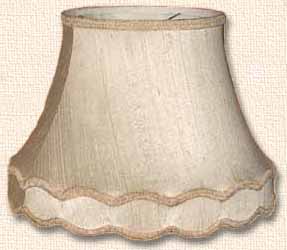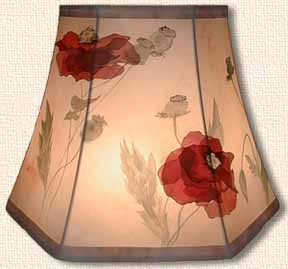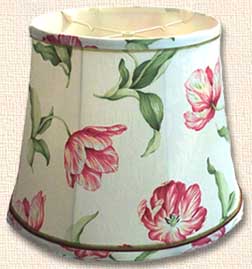|
|
|
Making Soft Lampshades
What's included . . .
Making Soft Lampshades is one chapter, divided into three sections—Making Stretch Shades, Making Victorian/Panel Shades, and the Sewing Primer. The chapter on Making Stretch Shades includes detailed instructions on how to make professional-quality, fully lined, round, oval, rectangular, square, hexagon, and other stretch-style lampshades. How to create matching trim and different kinds of ruffles is also included, as is discussion on scalloped and/or galleried shades, along with various kinds of pleats. Stretch shades do require basic sewing-machine skills, and all you need to acquire them is provided in the Sewing Primer. If you doubt your ability to learn how to sew, be sure to read the So, you say you can't sew, below.
If inclined to put off acting on the inspiration that brought you here, until you have the time to read everything included on this tour, keep in mind that all but What's included is repeated in the book. Since, in my experience, a creative urge delayed often leads to it's demise, may I suggest it's actually preferable to just scan through the tour, making it more enjoyable when reading these quotes in context. The bottom line to what it says is that anyone willing to give it a try can quickly learn how to make gorgeous lampshades, such as these created by Shadecrafters Club members (hover to see who and where).
Excerpts from intro to Making Stretch Shades . . .
|
|
"There's something about the look of fabric stretched so tautly over the frame of a stretch-style lampshade, the lining so perfectly smooth, that seems to cry out 'This has gotta be really hard to do!' I've seen enough failed attempts at re-covering these frames, the fabric all baggy and saggy, not to recognize a high-risk-for-failure craft when I see one."
"The ridiculous number of ragged stretch shades I had piling up in my basement (right next to a plethora of shadeless lamps in need of them) finally forced me to overcome these preconceived notions of difficulty. I decided to try making one to see how hard it really was. Now, I realize there's a good chance that, until you've made one yourself, you may not believe me when I say that this type of shade can be successfully accomplished by (almost) anyone willing to give it a try, but it's absolutely true."
|
 Roger, an upholsterer,
Roger, an upholsterer,
was asked to restore this scalloped and galleried lampshade. It was his first attempt at shadecrafting, and not a beginner-friendly frame or fabric. It looks like it was made by a pro.
|
 Sally already knew how to paint and dye silk, but she learned how to make lampshades from my book. For artists, this is a new way to stretch a canvas. See Testimonials for another of her amazing shades.
Sally already knew how to paint and dye silk, but she learned how to make lampshades from my book. For artists, this is a new way to stretch a canvas. See Testimonials for another of her amazing shades.
|
"Easy as stretch shades are to make, they do require a sewing machine, and I very much wanted to be able to provide a way for someone to make a fabric-covered lampshade by hand, without resorting to the use of glue (a messy, frustrating proposition, fraught with the potential for disaster, harder and more time consuming than sewing, even for a novice, and, I imagine, must take a whole lot more practice than I was willing to commit to, to get close to creating a nicely finished shade). I was most pleased to discover that the techniques used to make a Victorian-style shade can also be used to cover any kind of free-standing frame, without the need for a sewing machine."
|
|
"If you know how to sew, you will find making either style of shade a snap (and you won't believe how quickly they go together). However, you really need only basic sewing skills and a bit of patience. To help ensure the truth of this statement (and also because I have an aversion to instructions that assume one's level of ability), I've included the kind of detail that would be obvious to experienced sewers. My intention is that anyone willing to give making soft lampshades a try, can not only pull it off, but do it well."
|
 Deborah's excellent example of dressing a simple frame with a beautiful fabric to create a fabulous, stand-out lampshade.
Deborah's excellent example of dressing a simple frame with a beautiful fabric to create a fabulous, stand-out lampshade.
|
|
So, you say you can't sew
"I once saw a woman on a how-to show on television who, after displaying a challenging array of projects she'd accomplished during the process of decorating her home, sheepishly admitted she'd glued in the hems on her living room drapes, because she just could not sew (although she'd been willing and able to acquire numerous more-difficult skills). And, to say the least, she's not alone. The mere mention of the need for a needle and thread, let alone a sewing machine, can cause plenty of otherwise completely capable post-modern (whatever that means) women to launch into embarrassed explanations of why they can't sew (most men just laugh at the suggestion).
You can find regular reinforcement of this rampant sewing phobia every day on TV and in magazines. While projects requiring the use of a wide variety of tools and skills are daily fare, those requiring sewing and sewing machines seem to be few and far between. When it comes to projects that incorporate fabric, if it can possibly be put together with glue, Stitch Witchery, or staples, that's what they tell you to use, even if sewing would actually be a much better choice (glue can't be removed if you make a mistake, stitches easily can be).
The fact is, the sewing machine ain't nothin' but a power tool. It's a kind of electrified stapler that uses thread instead of wire, and if you think you can't possibly learn how to run one, I'll just betcha you're mistaken. If you think you can't even hand sew well enough to make a panel shade, I'll bet you're wrong about that, too.
Some people perceive this practical ability as an old-fashioned, time-consuming, nonessential, a difficult domestic chore, but the truth is, it's the exact opposite. No special talent or aptitude is required. It's not something one gender does better than the other. Truly, the hardest part of learning to sew is rethinking your creativity-limiting reaction to it; beyond that, it's really pretty easy, especially to reach the skill level necessary to make soft lampshades."
|
|
|
|
|

















